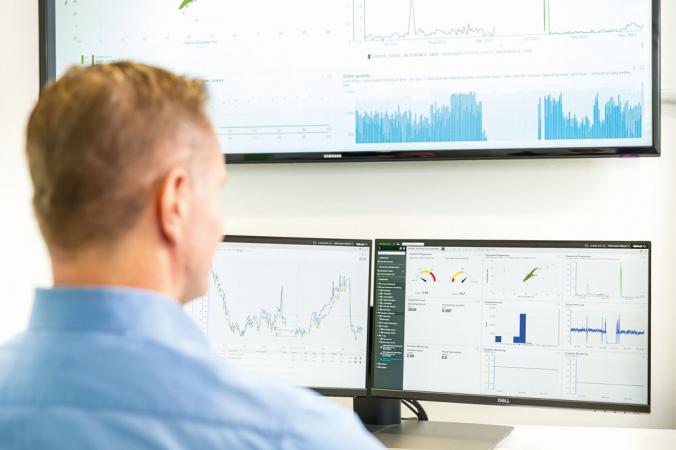CMMS and Kaizen: The Importance of Lean Maintenance in Today’s Manufacturing
Industry 4.0 sets high requirements to the industrial world. Automation, data exchange, IoT and cloud computing are just some of the recent preconditions for competitive and efficient production cycle. Equipment maintenance plays a critical role in smart manufacturing. But is it possible to sustain a lean manufacturing process without applying lean strategies to equipment maintenance? No.
Kaizen, which originates from Japanese and means “change for better”, is nothing new for the industrial world. Its continuous improvement, long-term approach can be applied to any single stage of the manufacturing cycle.
As a central organizational system at an industrial plant, a next-gen CMMS should feature all necessary characteristics in order to become a main kaizen tool. Progress in the technologies required by predictive maintenance and IIot (Industrial Internet of things) is swift and significant. A CMMS should be able to cope with the changes and gather, analyze and control the entire asset performance data.
How Does Kaizen Make Maintenance Lean?
There is not only one possible way to sustain kaizen. Every company can choose its own kaizen tools and shape its own kaizen approach. However the main target of kaizen is the gradual and continual improvement of processes involving all levels of the organization. “Muda” or the reduction of “waste”, meaning sustaining zero loses in every sphere of activity, is the motor of the approach.
Applied to equipment maintenance, the kaizen policy would include pursuit of cost reduction, precise spare parts management , use of predictive analytics and preventive maintenance, reduced defects and downtimes, effective scheduling of the operators and technicians activities. A good CMMS must enable all these important criteria to be fulfilled in order to significantly improve the plant’s overall performance. If a CMMS fails even in one of the mentioned requirements, the users will naturally refuse its adoption and it would not be qualified as a kaizen tool anymore.
Considering the fact that kaizen events are team-based achievements focused on improving a specific process or area, some example for kaizen equipment maintenance events could be the improvement of the MTTR (mean-to-repair-times) or team training about the efficient use of the CMMS and all its features. Nowadays, CMMS as the next-gen and 1st maintenance social network Mobility Work are so intuitive and easy to use that they do not require any training nor complicated set up. CMMS like this one were based upon the kaizen approach since their creation.
Common Lean Tools Applied to Equipment Maintenance
There are many lean strategies that can be applied to equipment maintenance processes for waste removal and safety, quality and productivity improvement.
Depending on the company’s strategy, TPM (total productive maintenance) can be considered as a kaizen tool or kaizen can be seen as one of the pillars of TPM. Both indicate the strong connection between kaizen and TPM.
Lean maintenance embraces the fundamental concept of TPM proactivity through planned and scheduled actions, performed by empowered maintenance teams using the 5s process. The 5 Japanese S include:
seiri - elimination of unnecessary thing, seiton - order, methods, seisso – control, seiketsu – cleanliness, shitsuke – discipline. Analysis of asset condition monitoring data, resulting in predictive analytics, completes the TPM concept.
Some other examples for kaizen tools are SMED (Single-Minute Exchange of Die) and the OTED (One-Touch Exchange of Die).
What Criteria Should a CMMS Meet in Order to Become an Efficient Kaizen tool?
A CMMS should fulfill certain requirements in order to respond to the kaizen policy. There are still solutions on the market that are too expensive, hard to implement, user-unfriendly and require many training sessions and an IT skilled team. Today’s “smart” CMMS should feature an intuitive design, generate work orders and be easily integrated with other business systems across the plant as accounting and purchasing. Mobility Work next gen CMMS goes even further and provides maintenance technicians with social network and highly innovative decision-making tools. As a matter of fact, most companies belonging to the same industry use similar equipment and therefore share similar technical issues; For this reason, there is a huge need for real-time exchanges and community-based data analysis in the maintenance world.
Basic Criteria
As kaizen includes everyone in the organization, a CMMS should be first of all user-friendly in order to assist all employees in their ongoing efforts. From scheduling preventive maintenance to managing spare parts, a good CMMS simplifies every single maintenance operation.
In the best case, a CMMS doesn’t require any difficult installation, users get to know and use all the features in a short time and are able to carry out frequent updates on their own initiative. A good CMMS ensures that the teams are provided on time with all the necessary information to perform the scheduled tasks correctly. It also maintains and saves an accurate history of all interventions.
At a glance:
No installation and team training needed
User-friendly and mobile interface
A simplified data entry process regarding maintenance interventions
Computing infrastructure, support, reporting and excel history upload included
Document and spare parts search
Spare parts management
ERP connection
Further Criteria Concerning IIot and Predictive Analytics
With Industry 4.0, a CMMS should easily provide data analysis reports with integrated big data tools, connectable to any other application. This is of critical importance to predictive maintenance. Indeed, predictive analytics are based upon equipment condition monitoring data and forecast the remaining service life of machine components. In order to take actionable decisions, the raw equipment function data should be stored in a reliable CMMS and incorporated in the context of the overall asset health.
Latest CMMS can directly receive and treat data provided by sensors mounted on the equipment and immediately generate work orders. By Getting the best out of predictive maintenance and CMMS , combining all your equipment-related data in one system, you can predict future problems with an astonishing accuracy and thus prevent catastrophic breakdowns and improve production technology performance through higher machine availability and longer service lives.
Lean maintenance is a precondition for successful lean manufacturing. Applied the proactive concept of TPM and other kaizen tools, lean maintenance emphasizes the importance of a close link between maintenance and all the other company’s teams to ensure equipment reliability, minimize downtime and increase profitability.
Considered as an important kaizen tool, CMMS is at the heart of lean maintenance, ensuring tight control over a number of maintenance process elements from work planning, through inventory management to root-cause analyses.
Writer of this blog post for Maintworld-magazine: Ralitsa Peycheva
Ralitsa Peycheva is a technical content manager at Mobility Work (www.mobility-work.com), interested in latest machinery tools, technical maintenance, CMMS and big data; curious about new manufacturing methods; discovering, observing and admiring high-quality engineering.
Follow Ralitsa on Google+ and Twitter










